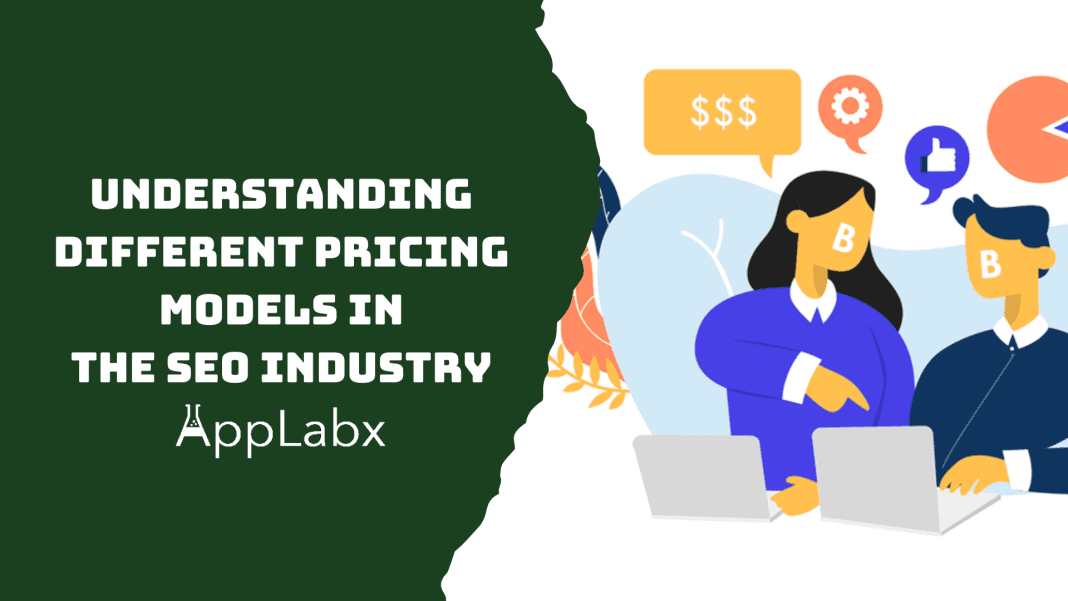Key Takeaways
- Tailored Strategies, Tailored Prices: Discover how aligning SEO pricing models with your business objectives ensures a customized strategy that optimizes your digital investment.
- Future-Proof Your SEO Investment: Anticipate industry shifts and technological advancements to choose pricing models that stand the test of time, keeping your digital strategy ahead of the curve.
- Results Rule All: Whether it’s hourly rates, project-based fees, or performance-based pricing, the common thread is results. Explore how each model contributes to the crescendo of SEO success for your business.
In the ever-evolving landscape of the digital realm, where online visibility is the key to success, Search Engine Optimization (SEO) emerges as the cornerstone of a robust digital strategy.
As businesses strive to climb the search engine rankings and secure a prime spot on the coveted first page, understanding the intricate world of SEO becomes imperative.
Amidst the myriad facets of optimizing for search engines, one crucial element that often leaves businesses in a quandary is determining the right pricing model for SEO services.

SEO Pricing Models
This blog embarks on a comprehensive exploration of the multifaceted universe of SEO pricing models, dissecting the intricacies that underlie the choices businesses face when seeking to enhance their online presence.
From the traditional hourly billing structures to the innovative performance-based models, we delve deep into the pros, cons, and nuances of each, offering a roadmap for businesses to navigate the maze of SEO pricing with confidence.
What Will Be Covered?
As we unravel the layers of this topic, we will not merely scratch the surface; rather, we’ll undertake a detailed journey into the foundations of SEO pricing, arming readers with the knowledge needed to make informed decisions that align seamlessly with their business goals and budgetary constraints.
Whether you are a seasoned marketer, a business owner looking to boost online visibility, or a curious mind intrigued by the dynamics of the digital realm, this exploration into SEO pricing promises to be a valuable resource.
Join us as we demystify the pricing structures that govern the SEO industry, shedding light on the factors that influence these models and providing real-world case studies that illustrate the triumphs and challenges faced by businesses on their SEO journey.
But, before we venture further, we like to share who we are and what we do.
About AppLabx
From developing a solid marketing plan to creating compelling content, optimizing for search engines, leveraging social media, and utilizing paid advertising, AppLabx offers a comprehensive suite of digital marketing services designed to drive growth and profitability for your business.
AppLabx is well known for helping companies and startups use SEO to drive web traffic to their websites and web apps.
At AppLabx, we understand that no two businesses are alike. That’s why we take a personalized approach to every project, working closely with our clients to understand their unique needs and goals, and developing customized strategies to help them achieve success.
If you need a digital consultation, then send in an inquiry here.
Understanding Different Pricing Models in the SEO Industry
- Common Pricing Models in the SEO Industry
- Performance-Based Pricing
- Factors Influencing Pricing Models
- How to Choose the Right Pricing Model
- Future Trends in SEO Pricing
1. Common Pricing Models in the SEO Industry

Hourly Rate in SEO
In the intricate world of SEO, the hourly rate pricing model is a traditional yet widely used approach. SEO professionals charge clients based on the number of hours dedicated to their projects. While this model offers transparency, it comes with both advantages and drawbacks.
Pros of Hourly Rate Billing:
- Transparency: Clients have a clear understanding of how their budget is utilized.
- Flexibility: Suited for small projects or tasks with undefined scopes.
Cons of Hourly Rate Billing:
- Potential for Overbilling: In cases where projects extend beyond initial estimates, costs can escalate.
- Client Uncertainty: Clients might be wary of unpredictable costs associated with hourly billing.
Project-Based Pricing in SEO
Project-based pricing involves setting a fixed cost for an entire SEO project, regardless of the hours invested. This model provides clients with a predetermined budget and is particularly suitable for well-defined projects.
Advantages of Project-Based Pricing:
- Budget Predictability: Clients know the total cost upfront, aiding financial planning.
- Clear Scope: Well-suited for projects with clearly defined objectives and deliverables.
Disadvantages of Project-Based Pricing:
- Scope Creep Management: Changes in project scope can be challenging to accommodate without altering the budget.
- Risk for Agencies: If underestimated, the agency might end up working at a loss.
Monthly Retainer Model in SEO
The monthly retainer model involves clients paying a fixed amount regularly for ongoing SEO services. This model fosters long-term partnerships and is often preferred for sustained SEO efforts.
Overview of Monthly Retainer Model:
- Stability for Agencies: Provides a consistent income stream for SEO service providers.
- Continuous Optimization: Allows ongoing adjustments and improvements over an extended period.
Predictable Costs for Clients:
- Budget Planning: Clients can allocate a fixed budget for SEO services each month.
- Continuous Attention: Ensures ongoing attention to the website’s SEO health.
Long-Term Benefits of Monthly Retainers:
- Relationship Building: Fosters a collaborative, long-term partnership between clients and agencies.
- Holistic Approach: Enables comprehensive SEO strategies with continuous monitoring and adjustments.
2. Performance-Based Pricing
Performance-based pricing in the SEO industry is a dynamic model where clients pay based on the actual results achieved, often measured by key performance indicators (KPIs) such as improved search rankings, increased organic traffic, or conversions.
This model aligns the interests of the client and the SEO agency, as payment is directly tied to the success of the campaign.

Explanation of Performance-Based Pricing:
- Risk-sharing: The agency shares the risk with the client by tying compensation to measurable outcomes.
- Results-driven: Encourages agencies to prioritize strategies that deliver tangible results.
Risks and Benefits for Clients and SEO Agencies:
Benefits for Clients:
- Cost Efficiency: Clients only pay for measurable success, ensuring a direct correlation between investment and outcomes.
- Increased Accountability: Agencies are motivated to deliver results to secure compensation.
Risks for Clients:
- Potential Higher Costs: If the agreed-upon success metrics are challenging, the cost per acquisition may be higher.
- Quality Concerns: Agencies might prioritize quick wins over long-term strategies, potentially affecting overall quality.
Benefits for SEO Agencies:
- Incentivizes Performance: Encourages agencies to continually optimize strategies for better results.
- Competitive Edge: Agencies offering performance-based pricing may attract clients seeking guaranteed outcomes.
Risks for SEO Agencies:
- Uncertain Income: If results are not achieved, the agency may face financial challenges.
- Strategic Limitations: Agencies may focus on short-term gains rather than holistic, long-term strategies.
Metrics Used in Performance-Based Pricing:
- Organic Traffic Growth: Increased organic traffic is a common metric, reflecting the success of SEO efforts.
- Conversion Rates: Clients often pay based on the number of conversions, emphasizing the quality of traffic.
- Keyword Rankings: Agencies may agree on payment based on improvements in keyword rankings.
3. Factors Influencing Pricing Models
Understanding the factors that influence pricing models in the SEO industry is paramount for businesses seeking optimal returns on their investments. Several key elements shape the choice of pricing models, ranging from project complexity to industry competition.

The complexity of the SEO Project:
- Scope of Work: The extent and intricacy of the SEO project play a pivotal role in determining the appropriate pricing model.
- Example: An extensive e-commerce website requiring comprehensive on-page optimization, content creation, and backlink building may be better suited for a project-based or retainer model due to its multifaceted nature.
- Technical Challenges: Projects involving intricate technical SEO, such as website migrations or addressing algorithmic penalties, may necessitate hourly billing to account for unpredictable troubleshooting.
Industry Competition:
- Competitive Landscape: The level of competition within a specific industry can influence the pricing model chosen by SEO agencies.
- Example: In highly competitive industries like finance or health, where SEO campaigns require a more aggressive and ongoing approach, agencies may lean towards monthly retainers to continually optimize and stay ahead of competitors.
- Keyword Difficulty: The difficulty of ranking for industry-specific keywords can impact the resources required, influencing pricing models accordingly.
Client’s Specific Needs and Goals:
- Customization Requirements: Tailoring SEO strategies to meet unique client needs may warrant a project-based or hourly billing approach.
- Example: A local business aiming for a quick online visibility boost may opt for hourly consulting to address immediate issues without committing to a long-term retainer.
- Short-Term vs. Long-Term Goals: Projects with short-term objectives, like a product launch, may benefit from project-based pricing, while businesses with ongoing SEO needs may find monthly retainers more suitable.
Duration and Scope of the Project:
- Timeline: The timeframe within which results are expected can influence the choice between hourly billing for short-term fixes and monthly retainers for sustained long-term strategies.
- Example: A startup with a limited budget aiming for a quick online presence might opt for hourly consulting to address immediate issues within a specific timeframe.
- Scalability: Projects with potential scalability or those requiring ongoing adjustments may lean towards monthly retainers to accommodate evolving needs seamlessly.
Client Budget Constraints:
- Affordability: The financial capacity of the client directly impacts the choice of pricing model.
- Example: A small business with a fixed budget might find hourly billing more manageable for sporadic consulting. At the same time, a larger enterprise with more resources may opt for a monthly retainer for continuous SEO efforts.
- ROI Expectations: Aligning the pricing model with expected returns is crucial to ensure a positive return on investment (ROI) for the client.
Industry Benchmarks and Standards:
- Market Rates: Understanding the prevailing market rates for SEO services within a specific industry guides both clients and agencies in setting realistic expectations.
- According to a survey by Ahrefs, $75–$100 per hour is the most popular hourly rate for SEOs.
- Service Package Trends: Analyzing common service packages and their associated costs helps in benchmarking against industry standards.
4. How to Choose the Right Pricing Model
Selecting the appropriate pricing model in the SEO landscape is a critical decision that can significantly impact the success of a digital marketing strategy.
By understanding key considerations and aligning them with business goals, organizations can make informed choices that optimize their investment in SEO services.

Assessing Business Goals and Budget:
- Define Objectives: Clearly articulate short-term and long-term SEO goals. Whether it’s boosting online visibility, driving traffic, or improving conversion rates, aligning objectives is crucial.
Example: A startup looking for a quick online presence boost may prioritize short-term goals, influencing the choice towards hourly consulting or project-based pricing.
- Budget Allocation: Evaluate the available budget for SEO services. Understanding financial constraints helps in narrowing down viable pricing models.
According to a study, the average cost of a quality SEO service ranges from $2,000 to $20,000 per month, emphasizing the variability in budget allocations.
Understanding the SEO Requirements:
- Scope of Work: Determine the complexity and scope of the SEO project. A detailed understanding of required services guides the selection of an appropriate pricing model.
Example: A comprehensive SEO overhaul, including technical optimization, content creation, and link-building, may favour a monthly retainer or project-based pricing.
- Technical Expertise: Projects with intricate technical SEO requirements may benefit from hourly billing to accommodate unpredictable problem-solving.
Evaluating Long-Term vs. Short-Term Needs:
- Project Duration: Assess the duration of SEO needs. Projects with ongoing, long-term requirements may be better suited for monthly retainers.
According to Semrush, it typically takes 4-12 months for SEO to work, emphasizing the need for a sustained approach.
- Immediate Objectives: Projects with immediate objectives, such as fixing critical issues, maybe more aligned with hourly billing for quick, targeted solutions.
Considering Scalability and Flexibility:
- Scalability: Evaluate the potential scalability of the project. Models like hourly billing may be suitable for smaller, scalable projects, while monthly retainers accommodate ongoing adjustments seamlessly.
Example: An e-commerce platform planning periodic product launches may find hourly billing adaptable to each launch’s unique needs.
- Flexibility: Choose a pricing model that accommodates unforeseen changes in project scope or business priorities.
Industry-Specific Considerations:
- Competitive Analysis: Assess the competitive landscape within the industry. Highly competitive sectors may benefit from ongoing optimization, favouring monthly retainers.
A study by Backlinko found that the top 3 Google search results get 54.4% of all clicks, emphasizing the competitive nature of SEO rankings.
- Keyword Difficulty: Industries with high keyword difficulty may require more extensive and ongoing SEO efforts, influencing the choice of a pricing model.
Client-Agency Relationship:
- Communication Style: Consider the preferred communication style and level of collaboration. Monthly retainers often foster a continuous, collaborative relationship.
Example: A hands-on client requiring regular updates and adjustments may find a monthly retainer more suitable.
- Transparency: Choose a pricing model that aligns with the desired level of transparency. Performance-based pricing, for example, emphasizes clear, measurable outcomes.
Risk Tolerance:
- Risk Mitigation: Assess the risk tolerance of both the client and the agency. Performance-based pricing shares risks and rewards, whereas hourly billing provides cost predictability.
- Contractual Flexibility: Opt for a pricing model that aligns with the desired level of contractual flexibility, especially when uncertainties or changes in project scope are anticipated.
5. Future Trends in SEO Pricing
As the digital landscape continues to evolve, the SEO industry is not immune to transformative shifts.
Anticipating future trends in SEO pricing is crucial for businesses seeking to stay ahead of the curve and align their strategies with emerging dynamics.

Emerging Pricing Models:
- Subscription-Based Models: The subscription-based model, where clients pay a recurring fee for ongoing SEO services, is gaining traction. This approach ensures continuous optimization and regular reporting, fostering long-term client-agency relationships.
Example: Some agencies are experimenting with subscription-based pricing, offering a fixed monthly fee for a bundle of SEO services, and providing clients with consistent support and predictable costs.
- Hybrid Models: Combining elements of hourly billing, project-based pricing, and retainers, hybrid models offer flexibility and customization, allowing businesses to tailor pricing structures to their unique needs.
Example: An agency might offer a base monthly retainer with additional hourly rates for specific ad-hoc tasks, providing clients with a personalized and adaptable pricing solution.
Impact of Technological Advancements:
- AI-Driven Automation: The integration of artificial intelligence (AI) in SEO tools is automating routine tasks such as keyword research, data analysis, and content optimization. This efficiency may influence pricing models by reducing manual labour costs.
- Predictive Analytics: Predictive analytics tools are becoming more sophisticated, allowing SEO professionals to forecast trends and outcomes accurately. This foresight can influence pricing models by emphasizing proactive strategies.
Example: An agency might incorporate predictive analytics to anticipate algorithm changes, enabling them to adjust strategies preemptively, and reflecting this in pricing structures.
Industry Shifts and Their Influence on SEO Costs:
- Voice Search Optimization: With the rise of voice search, optimizing content for natural language queries is becoming paramount. SEO agencies may adapt pricing models to include specialized services catering to voice search.
Forecasts suggest that by 2024, the number of digital voice assistants will reach 8.4 billion units – a number higher than the world’s population, underlining the significance of voice search optimization in future SEO strategies.
- E-E-A-T Focus: Google’s emphasis on Expertise, Experience, Authoritativeness, and Trustworthiness (E-E-A-T) is reshaping SEO strategies. Agencies may adjust pricing models to incorporate additional efforts in content creation, backlink building, and authority building.
Example: An agency might introduce a tiered pricing structure, with higher tiers including comprehensive E-E-A-T-focused strategies to meet evolving Google algorithms.
Industry Collaboration and Data Sharing:
- Collaboration Platforms: SEO agencies may increasingly leverage collaborative platforms and data-sharing initiatives. This collaborative approach could influence pricing models, with collective data insights contributing to more effective strategies.
According to a survey, 89 per cent of business leaders are prioritizing collaboration and teamwork as part of their organization’s overall workforce strategies, indicating a growing trend towards a collaborative approach.
- Transparency and Shared Metrics: Future pricing models may emphasize transparency and shared metrics between clients and agencies, fostering a results-driven partnership.
Example: An agency might offer transparent dashboards where clients can monitor real-time metrics and performance, aligning the pricing model with the shared goal of achieving specific KPIs.
Personalization and Customization:
- Personalized Packages: SEO agencies may move towards offering more personalized service packages based on individual client needs, allowing businesses to pay for services directly aligned with their goals.
Example: An agency might offer a menu of services, allowing clients to choose specific SEO components such as keyword research, content creation, or technical audits, tailoring the pricing to their exact requirements.
- Dynamic Pricing Algorithms: The use of dynamic pricing algorithms that adjust rates based on real-time demand, competition, and project complexity may become more prevalent, providing a fair and adaptable pricing structure.
Conclusion
In the labyrinth of digital marketing, where the pursuit of online visibility is both an art and a science, understanding the intricacies of SEO pricing models emerges as a beacon guiding businesses toward success.
As we traverse the diverse landscapes of hourly billing, project-based pricing, monthly retainers, and the innovative realm of performance-based models, it becomes evident that the right pricing strategy is not a one-size-fits-all equation.
It’s a strategic alliance between client objectives, industry dynamics, and the ever-evolving algorithms that govern the digital realm.
A Symphony of Choices
The symphony of SEO pricing choices orchestrates a melody where transparency, flexibility, and alignment with business goals take center stage.
The crescendo of hourly billing, with its transparency and adaptability, harmonizes with the well-structured opus of project-based pricing, offering a fixed cadence for well-defined projects.
Meanwhile, the steady rhythm of monthly retainers provides a continuous beat, sustaining the crescendo of SEO efforts over time.
The performance-based model, akin to an improvisational jazz piece, introduces an element of risk and reward, inviting businesses to dance on the edge of measurable success.
A Tapestry Woven with Factors
As we untangle the threads of factors influencing pricing decisions—project complexity, industry competition, client needs, project duration, budget constraints, and industry benchmarks—a tapestry emerges.
This intricate tapestry is not just a visual representation but a dynamic roadmap guiding businesses towards their goals. It’s a narrative where each decision influences the final masterpiece, and understanding the subtleties of each thread becomes paramount.
A Glimpse into the Future
As we gaze into the crystal ball of future trends, we see a landscape shaped by subscription-based models, AI-driven automation, predictive analytics, and a renewed focus on collaboration and transparency.
The future of SEO pricing is a canvas awaiting the strokes of personalization, customization, and dynamic algorithms that adapt to real-time demands. It’s a canvas where businesses no longer merely pay for services but invest in partnerships that fuel their digital journey.
In the End, It’s About Results
Amidst the sea of choices and future possibilities, one truth remains constant—the heart of SEO pricing is results.
Whether it’s the immediate impact of hourly consulting, the strategic depth of a retainer, or the measured success of performance-based models, businesses ultimately seek a return on their investment.
The clicks, conversions, and climb up the search engine ranks are the crescendo that every pricing model aspires to achieve.
Choosing Your Symphony
As businesses embark on their journey through the symphony of SEO pricing models, the key is not just to choose a melody but to conduct a symphony that resonates with their unique rhythm.
It’s about finding the sweet spot where business objectives, budget constraints, and the nuances of the industry converge.
It’s about selecting a symphony that evolves with the business, adapting to industry shifts, technological advancements, and the unpredictable cadence of the digital landscape.
In the grand finale of our exploration into “Understanding Different Pricing Models in the SEO Industry,” the echo is clear—it’s not just about understanding; it’s about empowerment.
Empowerment to make informed decisions, to navigate the complexities of the SEO landscape, and to orchestrate a symphony of success that reverberates across the digital horizon.
If you are looking for a top-class digital marketer, then book a free consultation slot here.
If you find this article useful, why not share it with your friends and business partners, and also leave a nice comment below?
We, at the AppLabx Research Team, strive to bring the latest and most meaningful data, guides, and statistics to your doorstep.
To get access to top-quality guides, click over to the AppLabx Blog.
People also ask
What are the pricing models for SEO?
Common pricing models for SEO include hourly billing, where clients pay per hour worked; project-based pricing, a fixed fee for a defined scope; monthly retainers, a recurring fee for ongoing services; and performance-based pricing, where payment is tied to achieved results. Each model offers unique advantages based on project complexity, client needs, and budget considerations.
What is performance-based SEO pricing?
Performance-based SEO pricing is a model where clients pay based on measurable outcomes, such as increased organic traffic, higher rankings, or improved conversions. This approach aligns the interests of the client and the SEO agency, emphasizing tangible results and ROI, and fostering a results-driven partnership.
What does SEO cost per month?
SEO costs per month vary based on factors like project scope, industry competition, and agency expertise. On average, businesses invest between $500 to $20,000 per month in SEO services. Customized packages and scalable solutions cater to diverse budgets, ensuring a tailored approach to digital success.




































